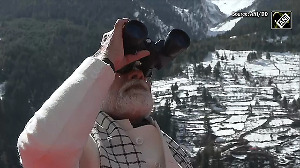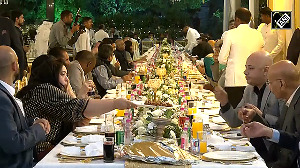 Pakistan-based Lashkar-e-Tayiba's technology chief had posed as an Indian businessman while negotiating to buy from an American company a Voice-over-Internet Phone service that was later used by the LeT handlers to communicate with 26/11 attackers while concealing their actual origin.
Pakistan-based Lashkar-e-Tayiba's technology chief had posed as an Indian businessman while negotiating to buy from an American company a Voice-over-Internet Phone service that was later used by the LeT handlers to communicate with 26/11 attackers while concealing their actual origin.
Zarrar Shah, a 30-year-old computer expert, was the technology chief of Lashkar-e-Taiba, and had set up an internet phone system to disguise his location during the 26/11 attacks by routing his calls through New Jersey.
A detailed investigative report by the New York Times, ProPublica and the PBS series Frontline titled 'In 2008 Mumbai Killings, Piles of Spy Data, but an Uncompleted Puzzle,' said that Shah, contacted the New Jersey company, "posing online as an Indian reseller of telephone services named Kharak Singh, purporting to be based in Mumbai.
"His Indian persona started haggling" over the price of the VoIP that had been chosen because it would make calls between Pakistan and the terrorists in Mumbai appear as if they were originating in Austria and New Jersey, it said.
"its not first time in my life i am perchasing in this VOIP business," (sic) Shah said in shaky English, to an official with the company when he thought the asking price was too high, according to British intelligence documents quoted in the report. "i am using these services from 2 years."
Shah had set up the VoIP service through the New Jersey company, ensuring that many of his calls to the terrorists would bear the area code 201, concealing their actual origin.
In November 2008 however, the company’s owner wrote to the fictitious Indian reseller Singh, complaining that no traffic was running on the digital phone network.
"Dear Sir, i will send trafic by the end of this month," (sic) Shah said in his ominous reply.
In a plan to pin the blame on Indian Muslims for the attacks, Shah had typed a statement of responsibility for the attack from the Hyderabad Deccan Mujahadeen -- a fake Indian organization.
Early on November 26, Shah emailed a draft of the phony claim to an underling with orders to send it to the news media later, according to American and Indian counterterrorism officials.
The report described Shah as a "digitally savvy operative" who had "strong ties to Pakistani intelligence and an intense hatred for India."
"As he made his plan, he searched on his laptop for weak communication security in Europe, spent time on a site designed to conceal browsing history, and searched Google News for "indian american naval exercises" --
In mid-September, during a session, which took place in a huge "media room" in a remote camp on the border with Jammu and Kashmir, Shah and fellow plotters used Google Earth and other material to show Ajmal Kasab and nine other terrorists their targets in Mumbai, according to court testimony.
Shortly before the assault in November 2008, Shah searched online for a Jewish hostel and two luxury hotels, all sites of the eventual carnage.
The session was part of an effort to chart the terrorists' route across the Arabian Sea, to a water landing on the edge of Mumbai, then through the chaotic streets.
Videos, maps and reconnaissance reports had been supplied to Mir by Pakistani-American David Headley.
"The gunmen were shown all this data from the reconnaissance," said Deven Bharti, a top Mumbai police official who investigated the attacks, adding that the terrorists were trained to use Google Earth and global positioning equipment on their own.
"Kasab was trained to locate everything in Mumbai before he went."
He also searched online for previous terror strikes in India and weather forecasts in the Arabian Sea, typed "4 star hotel in delhi" and "taj hotel," and visited mapsofindia.com to pore over sites in and around Mumbai, documents show.
"Still, the sheer scale of his ambition might have served as a smokescreen for his focus on the city," the report said, adding that he also showed interest in Kashmir, Punjab, New Delhi, Afghanistan and the US Army in Germany and Canada.
He constantly flipped back and forth among Internet porn and entertainment sites while he was carrying out his work.
By November 24, Shah had moved to the Karachi suburbs, where he set up an electronic "control room" with the help of an Indian militant named Abu Jundal, according to his later confession to the Indian authorities.
The report said that it was from this room that Mir, Shah and others issued minute-by-minute instructions to the assault team of 10 LeT men once the attacks began.
A day before the attacks, Jundal tested the VoIP software on four laptops spread out on four small tables facing a pair of televisions as the plotters, including Mir, Shah and LeT operations commander Zaki-ur-Rehman Lakhvi waited for the killings to begin.
"Before the attacks started that evening, the documents show, Shah pulled up Google images of the Oberoi Hotel and conducted Wikimapia searches for the Taj and the Chabad House,the report said, adding that he began Googling news coverage of Mumbai.












 © 2025
© 2025